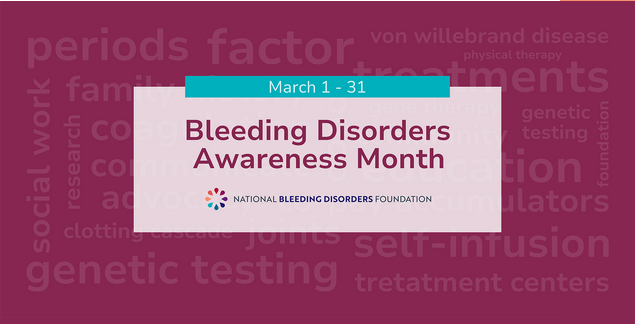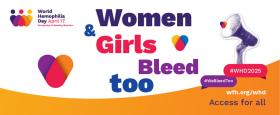Happy BDAM!

Bleeding Disorders Awareness Month (BDAM) takes place every March and it calls attention to the bleeding disorders community, while also serving as an opportunity for anyone in the community to share their story with others. BDAM was first acknowledged on a national scale in 2016, formerly known as Hemophilia Awareness Month. This name change was an important shift and validated the stories and experiences of thousands of people around the country.
In addition to Bleeding Disorders Awareness Month, March also happens to be Women’s History Month. So, to celebrate both awareness months, let’s highlight one of NBDF’s greatest successes for women, girls, and people with the potential to menstruate (WGPPM) this past year.
The most notable event was the WGPPM Summit that took place in May of 2023. This two-day summit featured testimonials from Lived Experience Experts (LEE) and panels from various organizations and stakeholders who are all invested in improving access to care and treatment for WGPPM. While two days was not nearly enough time to accomplish everything we wanted to, it was still packed with enriching conversations across a wide range of topics, from diagnosis and clinical management to the stigma and isolation that is experienced by women, girls, and people with the potential to menstruate across all bleeding disorders.
Out of the WGPPM Summit came a white paper that summarized the outcomes of the discussions at the summit and an opportunity for community members who weren’t able to attend to share their stories. This paper, combined with suggestions from the broader WGPPM community, helped us develop a better understanding of how to create impactful change and map out some of our WGPPM initiatives for 2024. The paper expressed a clear need for accessible resources and tools focused on the WGPPM community. This could come in the form of an educational resource library, a research portal that provides an overview of clinical trials for WGPPM, or even developing a gold standard for what WGPPM-focused bleeding disorder clinics should look like.
The paper also highlighted a shared desire to continue breaking down societal stigmas around periods, and to revise the way in which we refer to WGPPM with bleeding disorders. As we know, historically, hemophilia has always been considered a disorder that only affected men due to how it is inherited genetically. For several years, women could only be a “carrier”, which is a term that never fully encompassed the true experiences of women with bleeding disorders. “Symptomatic carrier” was a step in the right direction as it acknowledged that women do experience bleeding symptoms, but this term doesn’t mean much for insurance companies. While it may seem like a minor change in language, having a clear diagnosis of a bleeding disorder can change a woman’s life and validate the symptoms they’ve been experiencing for years. There has been so much progress over the years to elevate the voices of WGPPM with bleeding disorders and ensure the language we use is representative of their true experiences. But, there is always room for growth!
BDAM is a month focused entirely on the stories that come from all of you in the community. These stories help inspire change and push the needle forward for WGPPM all around the world. There are numerous activities and campaigns going on this month to spread awareness on the experiences of those with bleeding disorders. I hope you consider sharing your story too!
About The Author
You May Also Like

On April 17th join us to celebrate World Hemophilia Day and raise awareness about hemophilia and…
Share your voices, stories, artwork and videos.
